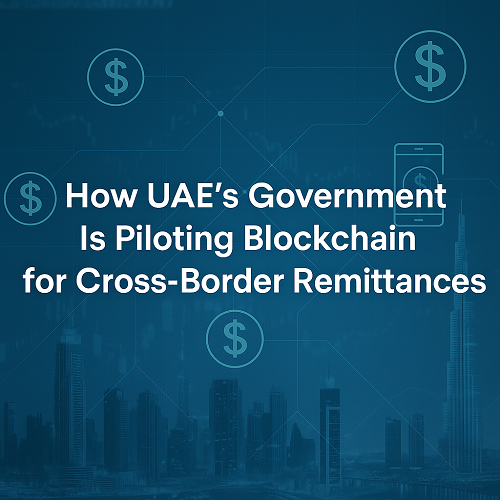Table of Contents
- Introduction
- The UAE’s Role in Global Cross-Border Remittances
- Challenges of Traditional Remittance Systems
- How Blockchain Is Revolutionizing UAE Remittances
- Benefits of Blockchain Remittances in UAE
- Key Government Pilots and Initiatives
- Global Use Cases and Regional Comparisons
- Challenges and Risks of Blockchain Adoption
- Regulatory Landscape for Blockchain Remittances UAE
- Case Study: UAE–India Blockchain Remittance Corridor
- FAQs About Blockchain Remittances UAE
- Conclusion
- Why Choose Websima for Blockchain Solutions
Introduction
The United Arab Emirates is one of the world’s largest remittance hubs, with billions flowing annually from expatriates to families worldwide. According to the World Bank, the UAE accounted for over $38.5 billion in outbound remittances in 2023, making it a top-five global corridor.
However, traditional remittance systems are slow, costly, and heavily intermediated. To address these challenges, the UAE government is piloting blockchain-powered remittance solutions under its broader Digital Economy Strategy.
These pilots aim to transform cross-border payments by ensuring:
- Faster settlements
- Lower transaction fees
- Enhanced transparency
- Improved compliance
The use of digital wallets in Dubai are increasing crypto usage and consequently can increase the usage of digital currencies for international payments.
The UAE’s Role in Global Cross-Border Remittances
✈️ Travelers in the UAE can now book flights with Bitcoin, Ethereum, USDT & more through Emirates, Travala, and Air Arabia.
Best place in the world to live especially if you are a crypto millionaire! ❤️ pic.twitter.com/3iwRZQvtM3
— MANDO CT (@XMaximist) August 16, 2025
Dubai and Abu Dhabi are home to over 9 million expatriates, making the UAE a critical hub for remittance outflows, particularly to:
- India
- Pakistan
- Philippines
- Bangladesh
- Egypt
This massive remittance market makes the UAE an ideal testbed for blockchain remittance pilots, offering scalable solutions that benefit both residents and receiving countries.
Reference: World Bank Migration and Development Brief 2023
Challenges of Traditional Remittance Systems

Despite their ubiquity, conventional remittance channels face significant limitations:
- High Transaction Costs
Traditional banks and money transfer operators charge 5%–12% per transaction. - Slow Settlement Times
Cross-border transfers can take 2 to 5 business days to clear. - Limited Transparency
Senders often cannot track payment progress in real time. - Multiple Intermediaries
Each participant adds complexity, risk, and fees.
Blockchain eliminates these frictions by creating a single, shared ledger where transactions are validated instantly.
How Blockchain Is Revolutionizing UAE Remittances
Blockchain technology enables trustless, peer-to-peer money transfers without centralized intermediaries. In the UAE, pilots leverage:
- Smart contracts to automate settlements.
- Tokenized AED and stablecoins for real-time payments.
- Immutable ledgers to enhance auditability.
- Cross-chain interoperability for seamless international corridors.
Dubai’s Virtual Assets Regulatory Authority (VARA) and the Central Bank of UAE are leading experiments with CBDCs (Central Bank Digital Currencies) and crypto-linked remittance rails.
Benefits of Blockchain Remittances in UAE

1. Speed
Blockchain reduces settlement times from days to minutes, enabling near-instant payouts.
2. Lower Costs
By eliminating intermediaries, blockchain remittance fees can drop by 50–70% compared to traditional providers.
3. Transparency
Senders and recipients can track transactions in real time using public ledgers.
4. Security
Encrypted and tamper-proof, blockchain remittances are more resilient to fraud.
5. Financial Inclusion
Low-cost digital rails make remittances more accessible to unbanked populations across Asia and Africa.
Key Government Pilots and Initiatives
Several UAE-driven projects highlight its commitment to blockchain remittances:
| Initiative | Description | Partners |
| Project Aber | UAE-Saudi pilot for a shared cross-border digital currency | UAE Central Bank, SAMA |
| mBridge | Blockchain-based multi-CBDC platform linking UAE, Hong Kong, Thailand, and China | BIS Innovation Hub |
| Dubai Blockchain Strategy 2020 | First roadmap for blockchain integration across government services | Smart Dubai, Dubai Future Foundation |
| RippleNet Collaborations | Partnerships with UAE Exchange and fintech firms for crypto-enabled corridors | Ripple, Lulu Exchange |
Learn More: Central Bank UAE – Digital Currency Initiatives
Global Use Cases and Regional Comparisons
The UAE isn’t alone in exploring blockchain remittances:
- Philippines: Coins.ph processes millions of blockchain-based remittances monthly.
- India: Integrating RippleNet corridors for Gulf remittance flows.
- El Salvador: Bitcoin integration for real-time, low-cost remittances.
Dubai’s regulatory-first approach makes it a model framework for balancing innovation and compliance in blockchain adoption.
Challenges and Risks of Blockchain Adoption
1. Regulatory Complexity
Cross-border payments must comply with AML/KYC rules and multiple jurisdictions.
2. Volatility Risks
Crypto-based remittances require stablecoins or CBDCs to mitigate price swings.
3. Interoperability
Seamless global integration demands cross-chain bridges between payment rails.
4. Consumer Education
End-users need guidance on wallet management, private keys, and transaction security.
Regulatory Landscape for Blockchain Remittances UAE
The UAE is building one of the world’s most comprehensive frameworks for digital finance:
- VARA regulates virtual assets in Dubai.
- Abu Dhabi Global Market (ADGM) hosts blockchain payment sandboxes.
- Dubai International Financial Centre (DIFC) enables fintech-driven remittance startups.
- Central Bank UAE oversees national settlement systems and digital dirham pilots.
Case Study: UAE–India Blockchain Remittance Corridor
Background:
India receives nearly $22 billion annually in remittances from the UAE.
Pilot:
UAE Exchange, in collaboration with RippleNet, tested a blockchain-powered corridor for real-time settlements.
Results:
- 90% faster transaction speeds.
- Reduced average remittance cost by 65%.
- Instant reconciliation for both sending and receiving banks.
This case illustrates how Blockchain Remittances UAE initiatives can transform financial flows at scale.
FAQs About Blockchain Remittances UAE
1. Are blockchain remittances legal in the UAE?
Yes, under VARA’s guidelines and approved partnerships.
2. Can workers send funds directly via blockchain wallets?
In regulated corridors, yes—pilots are integrating crypto-friendly rails for expats.
3. Will blockchain replace traditional remittance firms?
Not entirely. Many incumbents are adopting blockchain rather than being replaced.
Conclusion
With the UAE serving as a global remittance hub, its government-led blockchain pilots represent a game-changing step toward faster, cheaper, and safer cross-border payments.
As projects like mBridge and Project Aber mature, the UAE is poised to become a global leader in blockchain-enabled remittance corridors, reinforcing its reputation as a Web3 innovation hub.
Why Choose Websima for Blockchain Solutions
At Websima, we specialize in end-to-end blockchain development, helping enterprises, fintechs, and startups design, build, and launch next-generation remittance solutions.
Our expertise includes:
- Smart contract development for secure settlements.
- Stablecoin and CBDC integration.
- Cross-chain interoperability for global corridors.
- Regulatory compliance consulting tailored to UAE frameworks.
Transform your remittance platform today!
Contact Websima and explore how we can help you build scalable, secure, and compliant blockchain payment systems in the UAE.





